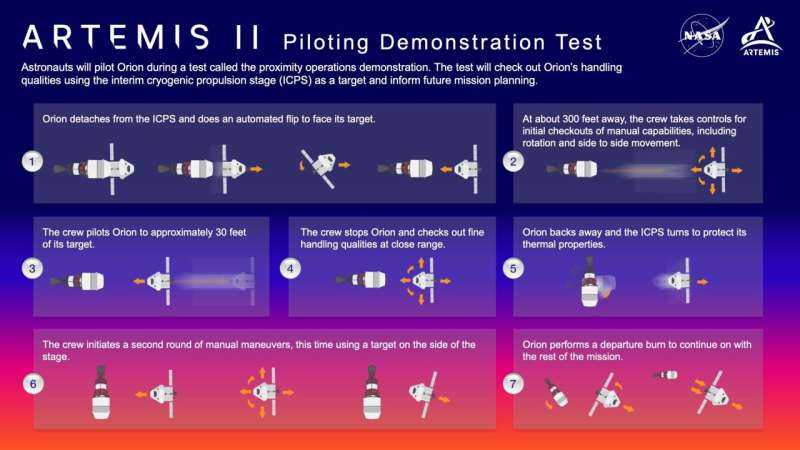"
After NASA's Reid Wiseman, Victor Glover, and Christina Koch, and CSA (Canadian Space Agency) astronaut Jeremy Hansen are safely in space, the moon rocket's upper stage will fire twice to put Orion on a high Earth orbit trajectory. Then, the spacecraft will automatically separate from the rocket stage, firing several separation bolts before springs push Orion a safe distance away.
As the spacecraft and its crew move away, Orion will perform an automated backflip to turn around and face the stage. At approximately 300 feet away, Orion will stop its relative motion. The crew will take control and use the translational and rotational hand controllers and display system to make very small movements to ensure Orion is responding as expected.
Next, the crew will very slowly pilot Orion to within approximately 30 feet of the stage. A two-foot auxiliary target mounted inside the top of the stage, similar to the docking target used by spacecraft visiting the International Space Station, will guide their aim.
"The crew will view the target by using a docking camera mounted inside the docking hatch window on the top of the crew module to see how well aligned they are with the docking target mounted to the ICPS," Anderson said. "It's a good stand in for what crews will see when they dock with Starship on Artemis III and to the Gateway on future missions."
About 30 feet from the stage, Orion will stop and the crew will checkout the spacecraft's fine handling qualities to evaluate how it performs in close proximity to another spacecraft. Small maneuvers performed very close to the ICPS will be done using the reaction control system thrusters on Orion's European Service Module.
Orion will then back away and allow the stage to turn to protect its thermal properties. The crew will follow the stage, initiate a second round of manual maneuvers using another target mounted on the side of the stage, approach within approximately 30 feet, perform another fine handling quality check out, then back away.
At the end of the demonstration, Orion will perform an automated departure burn to move away from the ICPS before the stage then fires to re-enter Earth's atmosphere over a remote location in the Pacific Ocean. During Orion's departure burn, engineers will use the spacecraft's docking camera to gather precise positioning measurements, which will help inform navigation during rendezvous activities on future missions in the lunar environment, where there is no GPS system.
Because the Artemis II Orion is not docking with another spacecraft, it is not equipped with a docking module containing lights and therefore is reliant on the ICPS to be lit enough by the sun to allow the crew to see the targets.
"As with many of our tests, it's possible the proximity operations demonstration won't go exactly as expected," said Anderson. "Even if we don't accomplish every part of the demonstration, we'll continue on with the test flight as planned to accomplish our primary objectives, including evaluating Orion's systems with crew aboard in the deep space environment and keeping the crew safe during the mission."
The approximately 10-day Artemis II flight will test NASA's foundational human deep space exploration capabilities, the SLS rocket and Orion spacecraft, for the first time with astronauts and will pave the way for lunar surface missions, including landing the first woman, first person of color, and first international partner astronaut on the moon.
Provided by NASA



